Optimization of As(V) Removal by Dried Bacterial Biomass: Nonlinear and Linear Regression Analysis for Isotherm and Kinetic Modelling
Abstract
1. Introduction
2. Materials and Methods
2.1. As(V) Analysis
2.2. Preparation of Dried Bacterial Biomass of WS3 (DBB)
2.3. Optimization of As(V) Removal
2.3.1. The Impact of Contact Time on the Removal of As(V)
2.3.2. The Impact of Initial Concentration on the Removal of As(V)
2.3.3. The Impact of pH on the Removal of As(V)
2.3.4. The Impact of Temperature on the Removal of As(V)
2.3.5. The Impact of Adsorbent Dosage on the Removal of As(V)
2.4. Batch Model Study
2.5. Comparison of FTIR and FESE-EDX Characterization Results for DBB before and after Adsorption of As(V)
2.6. Studies of Linear and Nonlinear Isotherm and Kinetic Models
3. Results and Discussion
3.1. Optimization of As(V) Removal
3.1.1. The Impact of Contact Time on the Removal of As(V)
3.1.2. The Impact of Initial Concentration on the Removal of As(V)
3.1.3. The Impact of pH on the Removal of As(V)
3.1.4. The Impact of Temperature on the Removal of As(V)
3.1.5. The Impact of Adsorbent Dosage on the Removal of As(V)
3.2. The Biomass Adsorption Capacity
| Bioadsorbents | As(V) mg/g | Reference |
|---|---|---|
| Acidithiobacillus ferrooxidans | 0.223 | [52] |
| Canna indica | 0.487 | [53] |
| Chitosan | 8 | [54] |
| Hibiscus rosasinensis | 0.432 | [53] |
| Functionalized nanocrystalline | 12.1 | [55] |
| Hydrilla verticilata | 11.65 | [56] |
| Stem of Tecomella undulata | 0.159 | [57] |
| Picea abies | 9.259 | [58] |
| DBB | 14 | This study |

3.3. Analysis of DBB Using Fourier Transform Infrared Spectroscopy (FTIR)
3.4. Comparative FESEM-EDX Study of DBB before and after As(V) Adsorption
3.5. Adsorption Isotherms Models
3.5.1. Comparison of the Linear and Nonlinear Langmuir Isotherm Model
3.5.2. Comparison of the Linear and Nonlinear Langmuir Isotherm Model
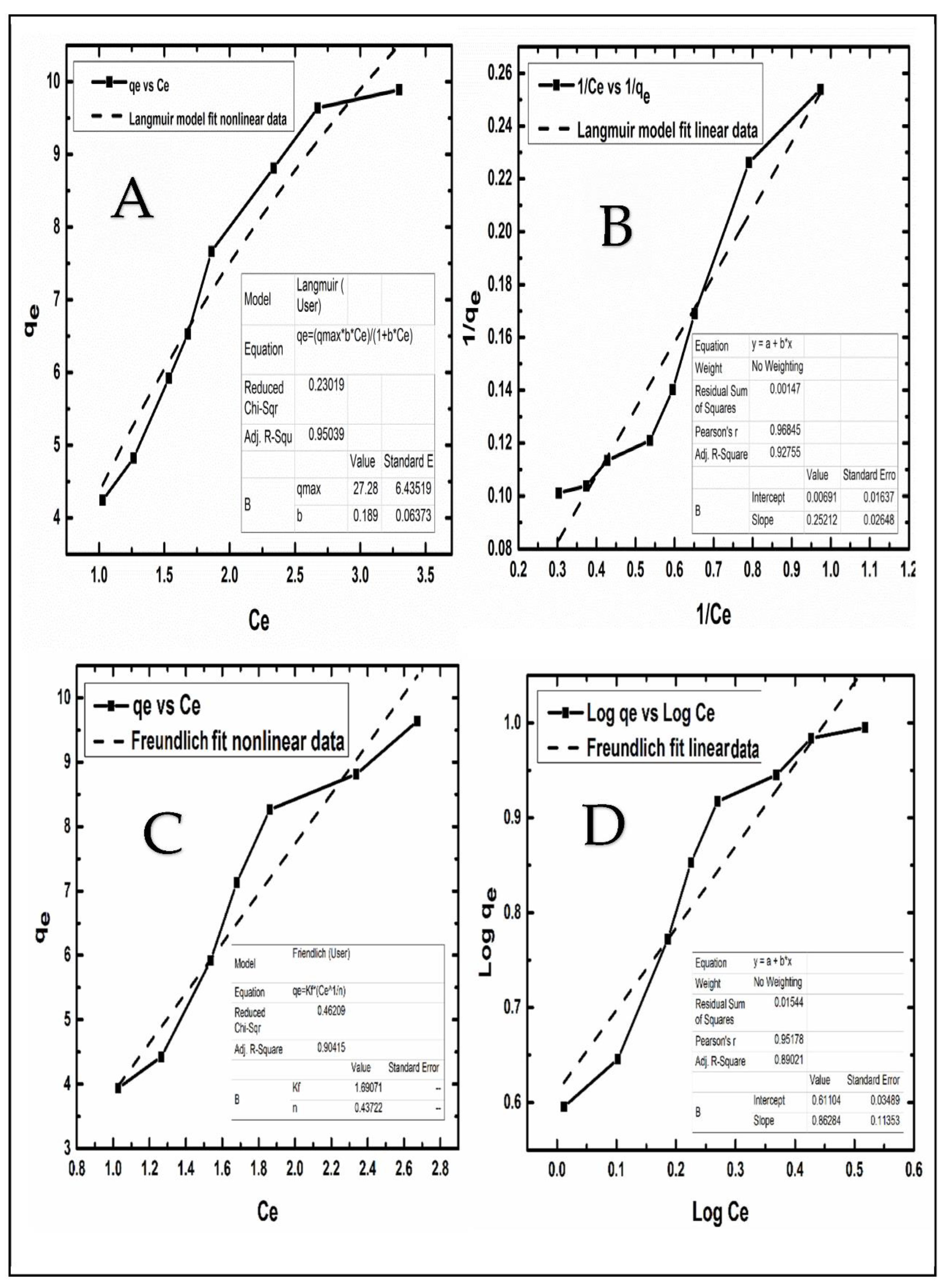
3.6. Kinetic Models of Adsorption Reactions
3.6.1. Comparison of a Linear and Nonlinear Pseudo-Second-Order Rate Model
3.6.2. Comparison of the Linear and Nonlinear Langmuir Isotherm Model
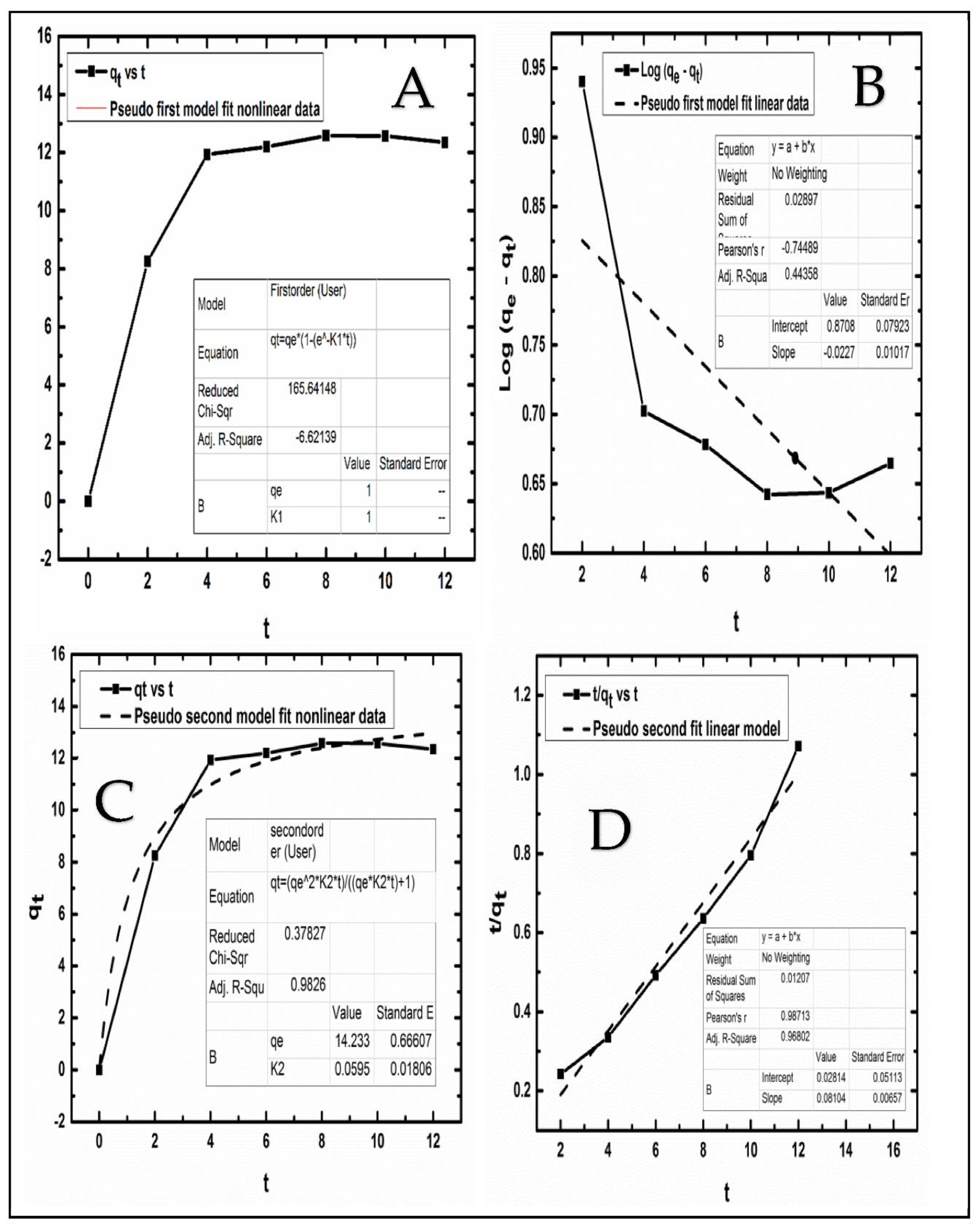
| Nonlinear Model | Plot | Linear Model | Plot | |
|---|---|---|---|---|
| Langmuir | vs. | 1/qe = (1/qmax + 1/b qmax. 1/Ce) | 1/qe vs. 1/Ce | |
| Freundlich | qe = KF Ce (1/n) | vs. | Log qe = Log KF + 1/n log Ce | Log qe vs. log Ce |
| Pseudo First | vs. | log (qe − qt) vs. t | ||
| Pseudo Second | vs. | t/qt vs. t |
3.7. Comparison of Nonlinear and Linear Models
4. Conclusions
Author Contributions
Funding
Institutional Review Board Statement
Informed Consent Statement
Data Availability Statement
Acknowledgments
Conflicts of Interest
References
- Asharuddin, S.M.; Othman, N.; Zin, N.S.M.; Tajarudin, H.A.; Din, M.F.M. Flocculation and antibacterial performance of dual coagulant system of modified cassava peel starch and alum. J. Water Process Eng. 2019, 31, 100888. [Google Scholar] [CrossRef]
- Ayob, S.; Othman, N.; Altowayti, W.A.H.; Khalid, F.S.; Bakar, N.A.; Tahir, M.; Soedjono, E.S. A review on adsorption of heavy metals from wood-industrial wastewater by oil palm waste. J. Ecol. Eng. 2021, 22, 3. [Google Scholar] [CrossRef]
- Nicomel, N.; Leus, K.; Folens, K.; Van Der Voort, P.; Du Laing, G. Technologies for arsenic removal from water: Current status and future perspectives. Int. J. Environ. Res. Public Health 2016, 13, 62. [Google Scholar] [CrossRef]
- Kartinen, E.O.; Martin, C.J. An overview of arsenic removal processes. Desalination 1995, 103, 79–88. [Google Scholar] [CrossRef]
- Smedley, P.L.; Kinniburgh, D.G. Source and behavior of arsenic in natural waters. In United Nations Synthesis Report on Arsenic in Drinking Water; World Health Organization: Geneva, Switzerland, 2001; pp. 1–61. [Google Scholar]
- van Halem, D.; Bakker, S.; Amy, G.; Van Dijk, J. Arsenic in drinking water: A worldwide water quality concern for water supply companies. Drink. Water Eng. Sci. 2009, 2, 29–34. [Google Scholar] [CrossRef]
- Jiang, J.-Q.; Ashekuzzaman, S.; Jiang, A.; Sharifuzzaman, S.; Chowdhury, S.R. Arsenic contaminated groundwater and its treatment options in Bangladesh. Int. J. Environ. Res. Public Health 2012, 10, 18–46. [Google Scholar] [CrossRef] [PubMed]
- ATSDR. ATSDR’s Substance Priority List. 2015. Available online: https://www.atsdr.cdc.gov/spl/resources/2015_atsdr_substance_priority_list.html (accessed on 29 August 2022).
- Robey, N.M.; Solo-Gabriele, H.M.; Jones, A.S.; Marini, J.; Townsend, T.G. Metals content of recycled construction and demolition wood before and after implementation of best management practices. Environ. Pollut. 2018, 242, 1198–1205. [Google Scholar] [CrossRef] [PubMed]
- Mandal, B.K.; Suzuki, K.T. Arsenic round the world: A review. Talanta 2002, 58, 201–235. [Google Scholar] [CrossRef]
- Flanagan, S.V.; Johnston, R.B.; Zheng, Y. Arsenic in tube well water in Bangladesh: Health and economic impacts and implications for arsenic mitigation. Bull. World Health Organ. 2012, 90, 839–846. [Google Scholar] [CrossRef]
- Kinniburgh, D.; Smedley, P. Arsenic contamination of groundwater in Bangladesh. Risk Manag. Healthc. Policy 2001, 11, 251–261. [Google Scholar]
- Amini, M.; Abbaspour, K.C.; Berg, M.; Winkel, L.; Hug, S.J.; Hoehn, E.; Yang, H.; Johnson, C.A. Statistical modeling of global geogenic arsenic contamination in groundwater. Environ. Sci. Technol. 2008, 42, 3669–3675. [Google Scholar] [CrossRef] [PubMed]
- Chun Ng, C.W.; Ismail, A.F.; Zaini Makhtar, M.M.; Fikri Jamaluddin, M.N.; Tajarudin, H.A. Conversion of food waste via two-stage fermentation to controllable chicken Feed Nutrients by local isolated microorganism. Int. J. Recycl. Org. Waste Agric. 2020, 9, 33–47. [Google Scholar]
- Azcue, J.M.; Nriagu, J.O. Impact of abandoned mine tailings on the arsenic concentrations in Moira Lake, Ontario. J. Geochem. Explor. 1995, 52, 81–89. [Google Scholar] [CrossRef]
- Button, M.; Moriarty, M.M.; Watts, M.J.; Zhang, J.; Koch, I.; Reimer, K.J. Arsenic speciation in field-collected and laboratory-exposed earthworms Lumbricus terrestris. Chemosphere 2011, 85, 1277–1283. [Google Scholar] [CrossRef] [PubMed]
- Smith, P.G.; Koch, I.; Reimer, K.J. Arsenic Speciation Analysis of Cultivated White Button Mushrooms (Agaricus bisporus) Using High-Performance Liquid Chromatography—Inductively Coupled Plasma Mass Spectrometry, and X-ray Absorption Spectroscopy. Environ. Sci. Technol. 2007, 41, 6947–6954. [Google Scholar] [CrossRef] [PubMed]
- Ravenscroft, P.; Brammer, H.; Richards, K. Arsenic Pollution: A Global Synthesis; John and Wiley and Sons: Hoboken, NJ, USA, 2009; Volume 28. [Google Scholar]
- Altowayti, W.A.H.; Othman, N.; Shahir, S.; Alshalif, A.; Al-Gheethi, A.; Al-Towayti, F.; Saleh, Z.; Haris, S. Removal of arsenic from wastewater by using different technologies and adsorbents: A review. Int. J. Environ. Sci. Technol. 2021, 19, 9243–9266. [Google Scholar] [CrossRef]
- Haris, S.A.; Altowayti, W.A.H.; Ibrahim, Z.; Shahir, S. Arsenic biosorption using pretreated biomass of psychrotolerant Yersinia sp. strain SOM-12D3 isolated from Svalbard, Arctic. Environ. Sci. Pollut. Res. 2018, 25, 27959–27970. [Google Scholar] [CrossRef] [PubMed]
- Altowayti, W.A.H.; Othman, N.; Goh, P.S.; Alshalif, A.F.; Al-Gheethi, A.A.; Algaifi, H.A. Application of a novel nanocomposites carbon nanotubes functionalized with mesoporous silica-nitrenium ions (CNT-MS-N) in nitrate removal: Optimizations and nonlinear and linear regression analysis. Environ. Technol. Innov. 2021, 22, 101428. [Google Scholar] [CrossRef]
- Hashim, M.A.; Kundu, A.; Mukherjee, S.; Ng, Y.-S.; Mukhopadhyay, S.; Redzwan, G.; Gupta, B.S. Arsenic removal by adsorption on activated carbon in a rotating packed bed. J. Water Process Eng. 2019, 30, 100591. [Google Scholar] [CrossRef]
- Çermikli, E.; Şen, F.; Altıok, E.; Wolska, J.; Cyganowski, P.; Kabay, N.; Bryjak, M.; Arda, M.; Yüksel, M. Performances of novel chelating ion exchange resins for boron and arsenic removal from saline geothermal water using adsorption-membrane filtration hybrid process. Desalination 2020, 491, 114504. [Google Scholar]
- Zhang, W.; Liu, C.; Wang, L.; Zheng, T.; Ren, G.; Li, J.; Ma, J.; Zhang, G.; Song, H.; Zhang, Z. A novel nanostructured Fe-Ti-Mn composite oxide for highly efficient arsenic removal: Preparation and performance evaluation. Colloids Surf. A Physicochem. Eng. Asp. 2019, 561, 364–372. [Google Scholar] [CrossRef]
- Alka, S.; Shahir, S.; Ibrahim, N.; Chai, T.-T.; Bahari, Z.M.; Abd Manan, F. The role of plant growth promoting bacteria on arsenic removal: A review of existing perspectives. Environ. Technol. Innov. 2020, 17, 100602. [Google Scholar]
- Asharuddin, S.M.; Othman, N.; Altowayti, W.A.H.; Bakar, N.A.; Hassan, A. Recent advancement in starch modification and its application as water treatment agent. Environ. Technol. Innov. 2021, 23, 101637. [Google Scholar] [CrossRef]
- Altowayti, W.A.H.; Othman, N.; Al-Gheethi, A.; Dzahir, N.H.b.M.; Asharuddin, S.M.; Alshalif, A.F.; Nasser, I.M.; Tajarudin, H.A.; Al-Towayti, F.A.H. Adsorption of Zn2+ from Synthetic Wastewater Using Dried Watermelon Rind (D-WMR): An Overview of Nonlinear and Linear Regression and Error Analysis. Molecules 2021, 26, 6176. [Google Scholar] [CrossRef]
- Srenscek-Nazzal, J.; Narkiewicz, U.; Morawski, A.W.; Wróbel, R.J.; Michalkiewicz, B. Comparison of optimized isotherm models and error functions for carbon dioxide adsorption on activated carbon. J. Chem. Eng. Data 2015, 60, 3148–3158. [Google Scholar] [CrossRef]
- Ho, Y.; Porter, J.; McKay, G. Equilibrium isotherm studies for the sorption of divalent metal ions onto peat: Copper, nickel and lead single component systems. Water Air Soil Pollut. 2002, 141, 1–33. [Google Scholar] [CrossRef]
- Carneiro, M.A.; Pintor, A.M.; Boaventura, R.A.; Botelho, C.M. Current trends of arsenic adsorption in continuous mode: Literature review and future perspectives. Sustainability 2021, 13, 1186. [Google Scholar] [CrossRef]
- Zeng, H.; Yu, Y.; Wang, F.; Zhang, J.; Li, D. Arsenic (V) removal by granular adsorbents made from water treatment residuals materials and chitosan. Colloids Surf. A Physicochem. Eng. Asp. 2020, 585, 124036. [Google Scholar] [CrossRef]
- Hao, L.; Liu, M.; Wang, N.; Li, G. A critical review on arsenic removal from water using iron-based adsorbents. RSC Adv. 2018, 8, 39545–39560. [Google Scholar] [CrossRef]
- Igwe, J.; Abia, A. A bioseparation process for removing heavy metals from waste water using biosorbents. Afr. J. Biotechnol. 2006, 5, 1167–1179. [Google Scholar]
- Saqib, A.N.S.; Waseem, A.; Khan, A.F.; Mahmood, Q.; Khan, A.; Habib, A.; Khan, A.R. Arsenic bioremediation by low cost materials derived from Blue Pine (Pinus wallichiana) and Walnut (Juglans regia). Ecol. Eng. 2013, 51, 88–94. [Google Scholar] [CrossRef]
- Altowayti, W.A.H.; Haris, S.A.; Shahir, S.; Zakaria, Z.; Ibrahim, S. The removal of arsenic species from aqueous solution by indigenous microbes: Batch bioadsorption and artificial neural network model. Environ. Technol. Innov. 2020, 19, 100830. [Google Scholar] [CrossRef]
- Altowayti, W.A.H.; Algaifi, H.A.; Bakar, S.A.; Shahir, S. The adsorptive removal of As (III) using biomass of arsenic resistant Bacillus thuringiensis strain WS3: Characteristics and modelling studies. Ecotoxicol. Environ. Saf. 2019, 172, 176–185. [Google Scholar] [CrossRef] [PubMed]
- Altowayti, W.A.H.; Dahawi, A.A.; Shahir, S. Significance of bio-treatment by acid washing for enlargement of arsenic desorption in indigenous arsenic-resistant bacteria from gold mine. Malays. J. Fundam. Appl. Sci. 2020, 16, 190–195. [Google Scholar] [CrossRef]
- Altowayti, W.A.H.; Almoalemi, H.; Shahir, S.; Othman, N. Comparison of culture-independent and dependent approaches for identification of native arsenic-resistant bacteria and their potential use for arsenic bioremediation. Ecotoxicol. Environ. Saf. 2020, 205, 111267. [Google Scholar] [CrossRef] [PubMed]
- Panda, H.; Tiadi, N.; Mohanty, M.; Mohanty, C. Studies on adsorption behavior of an industrial waste for removal of chromium from aqueous solution. S. Afr. J. Chem. Eng. 2017, 23, 132–138. [Google Scholar] [CrossRef]
- Batool, F.; Akbar, J.; Iqbal, S.; Noreen, S.; Bukhari, S.N.A. Study of isothermal, kinetic, and thermodynamic parameters for adsorption of cadmium: An overview of linear and nonlinear approach and error analysis. Bioinorg. Chem. Appl. 2018, 2018, 1–11. [Google Scholar] [CrossRef]
- Yang, S.; Li, J.; Shao, D.; Hu, J.; Wang, X. Adsorption of Ni (II) on oxidized multi-walled carbon nanotubes: Effect of contact time, pH, foreign ions and PAA. J. Hazard. Mater. 2009, 166, 109–116. [Google Scholar] [CrossRef]
- Kord Mostafapour, F.; Bazrafshan, E.; Farzadkia, M.; Amini, S. Arsenic removal from aqueous solutions by Salvadora persica stem ash. J. Chem. 2013, 2013, 1–8. [Google Scholar] [CrossRef]
- Zang, S.; Qiu, H.; Sun, C.; Zhou, H.; Cui, L. High Efficiency Adsorption Removal of Arsenilic Acid and Arsenate (V) by Iron-Modified Corncob Biochar. Bull. Environ. Contam. Toxicol. 2022, 109, 379–385. [Google Scholar] [CrossRef]
- Gupta, A.R.; Joshi, V.C.; Yadav, A.; Sharma, S. Synchronous removal of arsenic and fluoride from aqueous solution: A facile approach to fabricate novel functional metallopolymer microspheres. ACS Omega 2022, 7, 4879–4891. [Google Scholar] [CrossRef]
- Smedley, P.L.; Kinniburgh, D.G. A review of the source, behaviour and distribution of arsenic in natural waters. Appl. Geochem. 2002, 17, 517–568. [Google Scholar] [CrossRef]
- Carneiro, M.A.; Pintor, A.M.; Boaventura, R.A.; Botelho, C.M. Efficient removal of arsenic from aqueous solution by continuous adsorption onto iron-coated cork granulates. J. Hazard. Mater. 2022, 432, 128657. [Google Scholar] [CrossRef] [PubMed]
- Goren, A.Y.; Kobya, M.; Khataee, A. How does arsenic speciation (arsenite and arsenate) in groundwater affect the performance of an aerated electrocoagulation reactor and human health risk? Sci. Total Environ. 2022, 808, 152135. [Google Scholar] [CrossRef] [PubMed]
- Zhu, T.; Zhang, Y.; Chen, Y.; Liu, J.-L.; Song, X.-L. Synthesis of novel hydrated ferric oxide biochar nanohybrids for efficient arsenic removal from wastewater. Rare Met. 2022, 41, 1677–1687. [Google Scholar] [CrossRef]
- Kujala, K.; Laamanen, T.; Khan, U.A.; Besold, J.; Planer-Friedrich, B. Kinetics of arsenic and antimony reduction and oxidation in peatlands treating mining-affected waters: Effects of microbes, temperature, and carbon substrate. Soil Biol. Biochem. 2022, 167, 108598. [Google Scholar] [CrossRef]
- Zubair, M.; Daud, M.; McKay, G.; Shehzad, F.; Al-Harthi, M.A. Recent progress in layered double hydroxides (LDH)-containing hybrids as adsorbents for water remediation. Appl. Clay Sci. 2017, 143, 279–292. [Google Scholar] [CrossRef]
- Lee, S.Y.; Jung, K.-W.; Choi, J.-W.; Lee, Y.J. In situ synthesis of hierarchical cobalt-aluminum layered double hydroxide on boehmite surface for efficient removal of arsenate from aqueous solutions: Effects of solution chemistry factors and sorption mechanism. Chem. Eng. J. 2019, 368, 914–923. [Google Scholar] [CrossRef]
- Yan, L.; Yin, H.; Zhang, S.; Leng, F.; Nan, W.; Li, H. Biosorption of inorganic and organic arsenic from aqueous solution by Acidithiobacillus ferrooxidans BY-3. J. Hazard. Mater. 2010, 178, 209–217. [Google Scholar] [CrossRef]
- Nigam, S.; Vankar, P.S.; Gopal, K. Biosorption of arsenic from aqueous solution using dye waste. Environ. Sci. Pollut. Res. 2013, 20, 1161–1172. [Google Scholar] [CrossRef]
- Kwok, K.C.; Koong, L.F.; Al Ansari, T.; McKay, G. Adsorption/desorption of arsenite and arsenate on chitosan and nanochitosan. Environ. Sci. Pollut. Res. 2018, 25, 14734–14742. [Google Scholar] [CrossRef]
- Singh, R.; Singh, S.; Parihar, P.; Singh, V.P.; Prasad, S.M. Arsenic contamination, consequences and remediation techniques: A review. Ecotoxicol. Environ. Saf. 2015, 112, 247–270. [Google Scholar] [CrossRef] [PubMed]
- Nigam, S.; Gopal, K.; Vankar, P.S. Biosorption of arsenic in drinking water by submerged plant: Hydrilla verticilata. Environ. Sci. Pollut. Res. 2013, 20, 4000–4008. [Google Scholar] [CrossRef]
- Brahman, K.D.; Kazi, T.G.; Baig, J.A.; Afridi, H.I.; Arain, S.S.; Saraj, S.; Arain, M.B.; Arain, S.A. Biosorptive removal of inorganic arsenic species and fluoride from aqueous medium by the stem of Tecomella undulate. Chemosphere 2016, 150, 320–328. [Google Scholar] [CrossRef] [PubMed]
- Urik, M.; Littera, P.; Kolen, M. Removal of arsenic (V) from aqueous solutions using chemically modified sawdust of spruce (Picea abies): Kinetics and isotherm studies. Int. J. Environ. Sci. Technol. 2009, 6, 451–456. [Google Scholar] [CrossRef]
- Giri, A.; Patel, R.; Mahapatra, S.; Mishra, P. Biosorption of arsenic (III) from aqueous solution by living cells of Bacillus cereus. Environ. Sci. Pollut. Res. 2012, 20, 1281–1291. [Google Scholar] [CrossRef] [PubMed]
- Dadrasnia, A.; Chuan Wei, K.S.; Shahsavari, N.; Azirun, M.S.; Ismail, S. Biosorption potential of Bacillus salmalaya strain 139SI for removal of Cr (VI) from aqueous solution. Int. J. Environ. Res. Public Health 2015, 12, 15321–15338. [Google Scholar] [CrossRef]
- Bahari, Z.M.; Altowayti, W.A.H.; Ibrahim, Z.; Jaafar, J.; Shahir, S. Biosorption of As (III) by non-living biomass of an arsenic-hypertolerant Bacillus cereus strain SZ2 isolated from a gold mining environment: Equilibrium and kinetic study. Appl. Biochem. Biotechnol. 2013, 171, 2247–2261. [Google Scholar] [CrossRef] [PubMed]
- Allozy, H.G.A.; Abd Karim, K.J. Removal of copper ions from aqueous solutions using poly (vinylbenzyl chloride). Malays. J. Anal. Sci 2020, 24, 978–991. [Google Scholar]
- Khashbaatar, Z.; Akama, S.; Kano, N.; Kim, H.-J. Development of a New Dolomite-Based Adsorbent with Phosphorus and the Adsorption Characteristics of Arsenic (III) in an Aqueous Solution. Water 2022, 14, 1102. [Google Scholar] [CrossRef]
- Aziz, N.I.A.; Othman, N.; Altowayti, W.A.H.; Yunus, Z.M.; Fitriani, N.; Din, M.F.M.; Fikri, F.M. Hardness removal of groundwater through sand, zeolite and rice husk activated carbon. Malays. J. Anal. Sci. 2021, 25, 605–621. [Google Scholar]
- Liyun, Y.; Mengdan, G.; Yan, L.; Shaojie, L.; Libing, Y.; Shuwu, L. Removal Arsenic (V) Efficiency and Characteristics Using Modified Basic Oxygen Furnace Slag in Aqueous Solution. J. Resour. Ecol. 2022, 13, 537–546. [Google Scholar] [CrossRef]
- Wu, D.; Liu, J.; Yang, Y.; Zheng, Y.; Zhang, J. Experimental and theoretical study of arsenic removal by porous carbon from MSW incineration flue gas. Fuel 2022, 312, 123000. [Google Scholar] [CrossRef]
- Van Tran, T.; Nguyen, D.T.C.; Nguyen, T.T.; Pham, Q.T.; Vo, D.-V.N.; Nguyen, T.-D.; Van Pham, T.; Nguyen, T.D. Linearized and nonlinearized modellings for comparative uptake assessment of metal-organic framework-derived nanocomposite towards sulfonamide antibiotics. Environ. Sci. Pollut. Res. 2020, 28, 63448–63463. [Google Scholar] [CrossRef] [PubMed]
- Yavari, Z.; Noroozifar, M. Kinetic, isotherm and thermodynamic studies with linear and non-linear fitting for cadmium (II) removal by black carbon of pine cone. Water Sci. Technol. 2017, 76, 2242–2253. [Google Scholar] [CrossRef] [PubMed]
- Kumar, K.V. Comparative analysis of linear and non-linear method of estimating the sorption isotherm parameters for malachite green onto activated carbon. J. Hazard. Mater. 2006, 136, 197–202. [Google Scholar] [CrossRef]
- Castro, L.; Ayala, L.A.; Vardanyan, A.; Zhang, R.; Muñoz, J.Á. Arsenate and Arsenite Sorption Using Biogenic Iron Compounds: Treatment of Real Polluted Waters in Batch and Continuous Systems. Metals 2021, 11, 1608. [Google Scholar] [CrossRef]
- Kumar, K.V. Optimum sorption isotherm by linear and non-linear methods for malachite green onto lemon peel. Dye. Pigment. 2007, 74, 595–597. [Google Scholar] [CrossRef]
- Chowdhury, S.; Misra, R.; Kushwaha, P.; Das, P. Optimum sorption isotherm by linear and nonlinear methods for safranin onto alkali-treated rice husk. Bioremediat. J. 2011, 15, 77–89. [Google Scholar] [CrossRef]
- Shahmohammadi-Kalalagh, S.; Babazadeh, H.; Nazemi, A. Comparison of linear and nonlinear forms of isotherm models for Zn (II) and Cu (II) sorption on a kaolinite. Arab. J. Geosci. 2015, 8, 397–402. [Google Scholar] [CrossRef]
- Kumar, K.V.; Porkodi, K.; Rocha, F. Isotherms and thermodynamics by linear and non-linear regression analysis for the sorption of methylene blue onto activated carbon: Comparison of various error functions. J. Hazard. Mater. 2008, 151, 794–804. [Google Scholar] [CrossRef]
- Altowayti, W.A.H.; Allozy, H.G.A.; Shahir, S.; Goh, P.S.; Yunus, M.A.M. A novel nanocomposite of aminated silica nanotube (MWCNT/Si/NH 2) and its potential on adsorption of nitrite. Environ. Sci. Pollut. Res. 2019, 26, 28737–28748. [Google Scholar] [CrossRef] [PubMed]
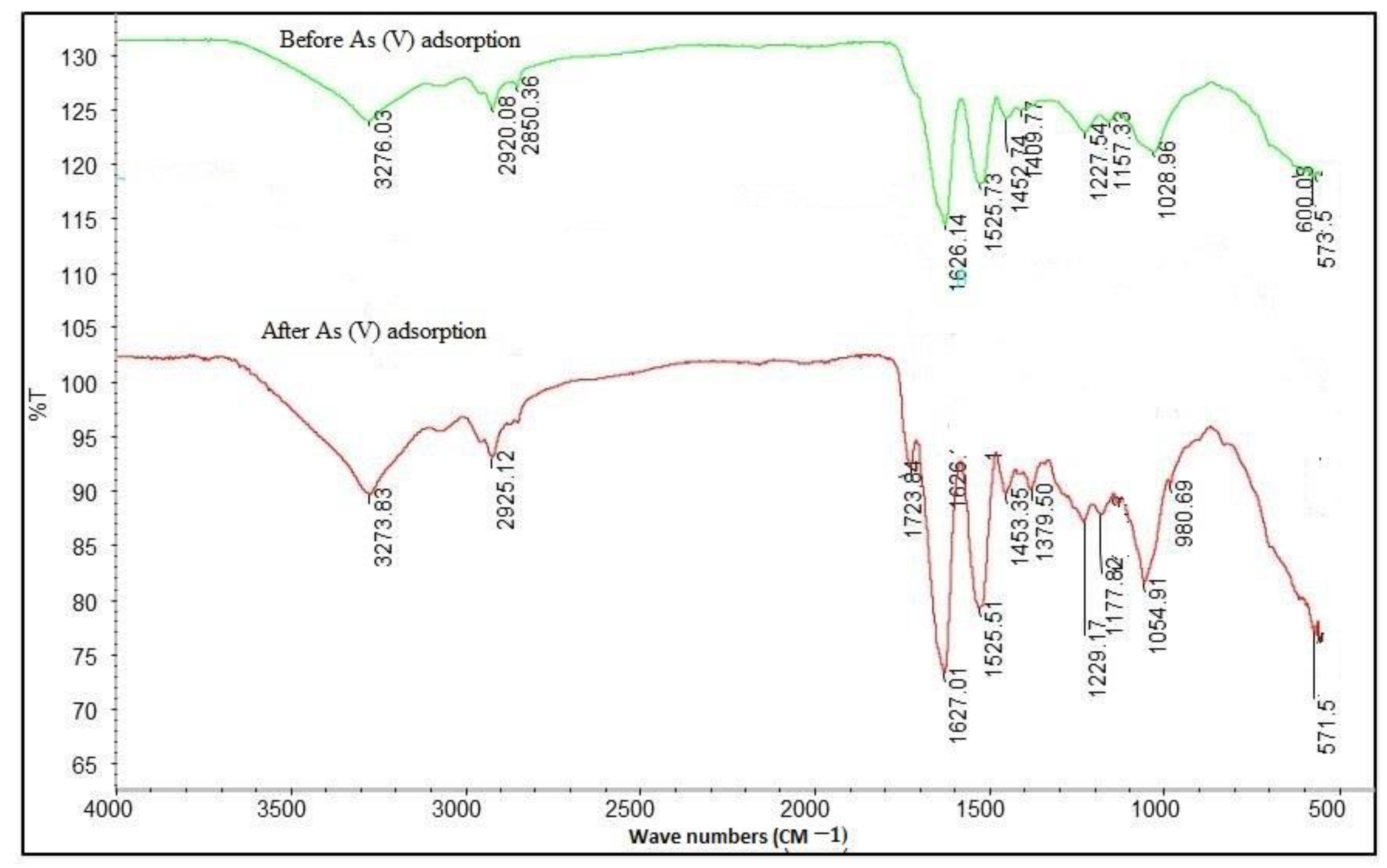
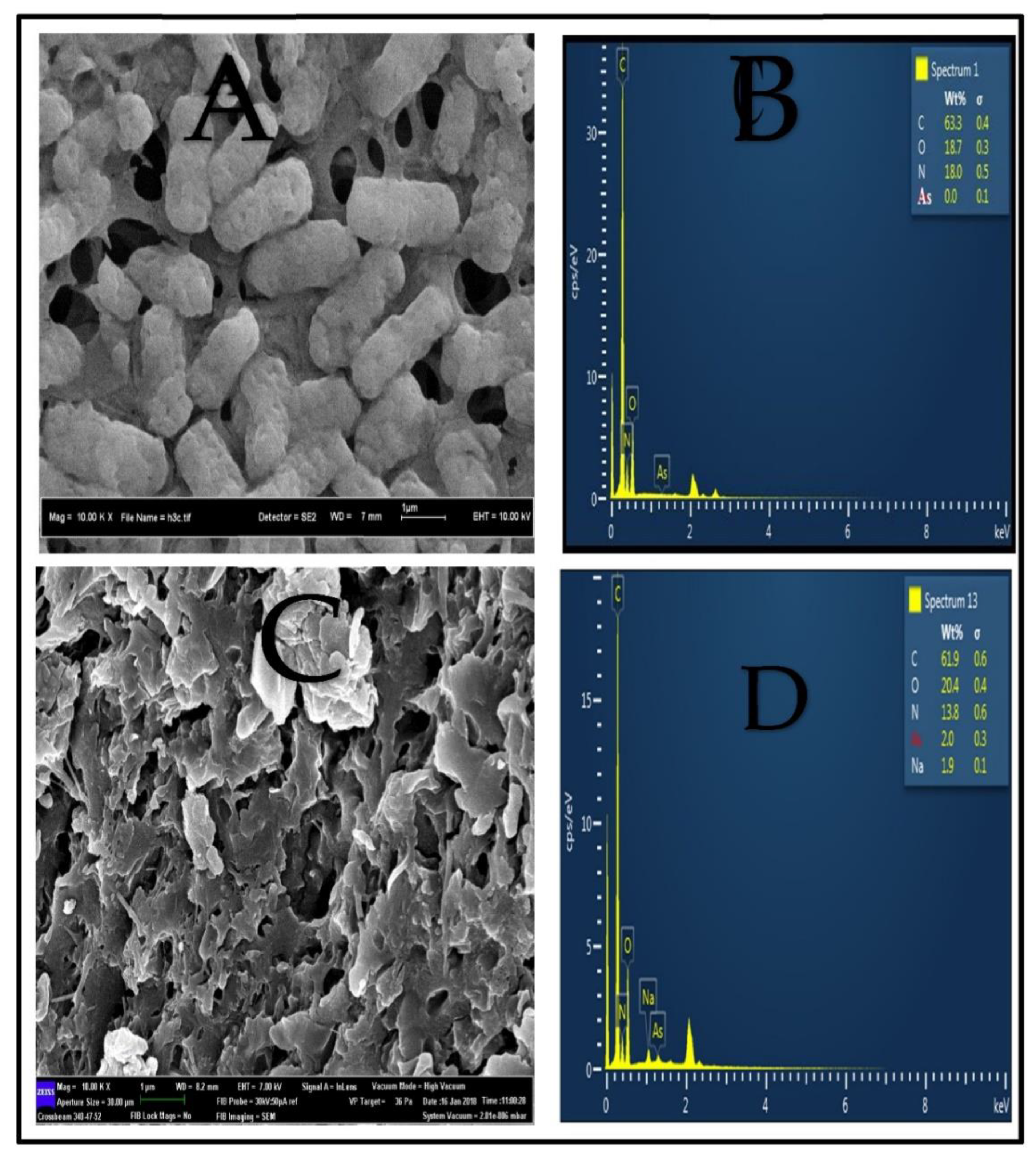
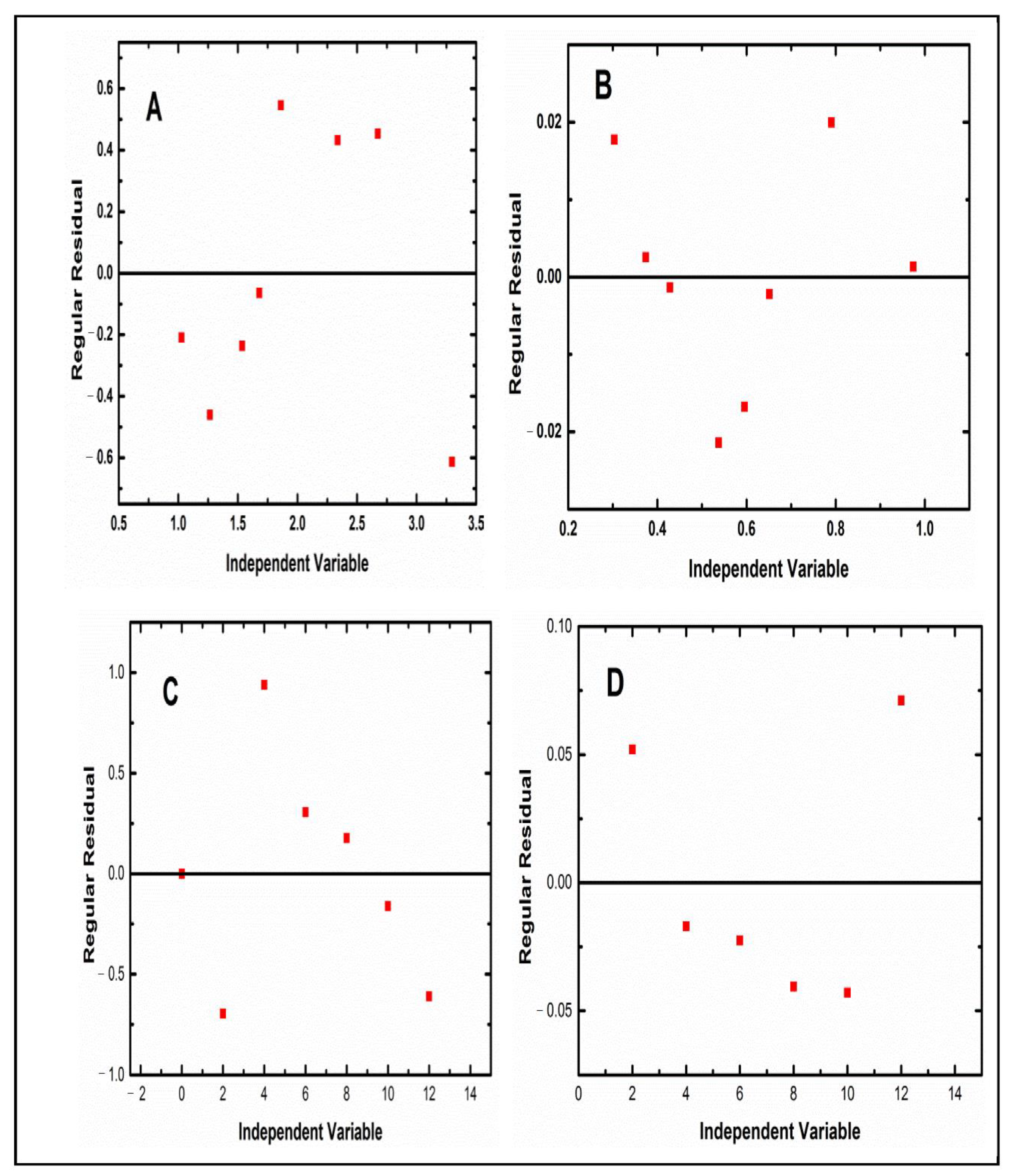
Publisher’s Note: MDPI stays neutral with regard to jurisdictional claims in published maps and institutional affiliations. |
© 2022 by the authors. Licensee MDPI, Basel, Switzerland. This article is an open access article distributed under the terms and conditions of the Creative Commons Attribution (CC BY) license (https://creativecommons.org/licenses/by/4.0/).
Share and Cite
Altowayti, W.A.H.; Salem, A.A.; Al-Fakih, A.M.; Bafaqeer, A.; Shahir, S.; Tajarudin, H.A. Optimization of As(V) Removal by Dried Bacterial Biomass: Nonlinear and Linear Regression Analysis for Isotherm and Kinetic Modelling. Metals 2022, 12, 1664. https://doi.org/10.3390/met12101664
Altowayti WAH, Salem AA, Al-Fakih AM, Bafaqeer A, Shahir S, Tajarudin HA. Optimization of As(V) Removal by Dried Bacterial Biomass: Nonlinear and Linear Regression Analysis for Isotherm and Kinetic Modelling. Metals. 2022; 12(10):1664. https://doi.org/10.3390/met12101664
Chicago/Turabian StyleAltowayti, Wahid Ali Hamood, Ali Ahmed Salem, Abdo Mohammed Al-Fakih, Abdullah Bafaqeer, Shafinaz Shahir, and Husnul Azan Tajarudin. 2022. "Optimization of As(V) Removal by Dried Bacterial Biomass: Nonlinear and Linear Regression Analysis for Isotherm and Kinetic Modelling" Metals 12, no. 10: 1664. https://doi.org/10.3390/met12101664
APA StyleAltowayti, W. A. H., Salem, A. A., Al-Fakih, A. M., Bafaqeer, A., Shahir, S., & Tajarudin, H. A. (2022). Optimization of As(V) Removal by Dried Bacterial Biomass: Nonlinear and Linear Regression Analysis for Isotherm and Kinetic Modelling. Metals, 12(10), 1664. https://doi.org/10.3390/met12101664








